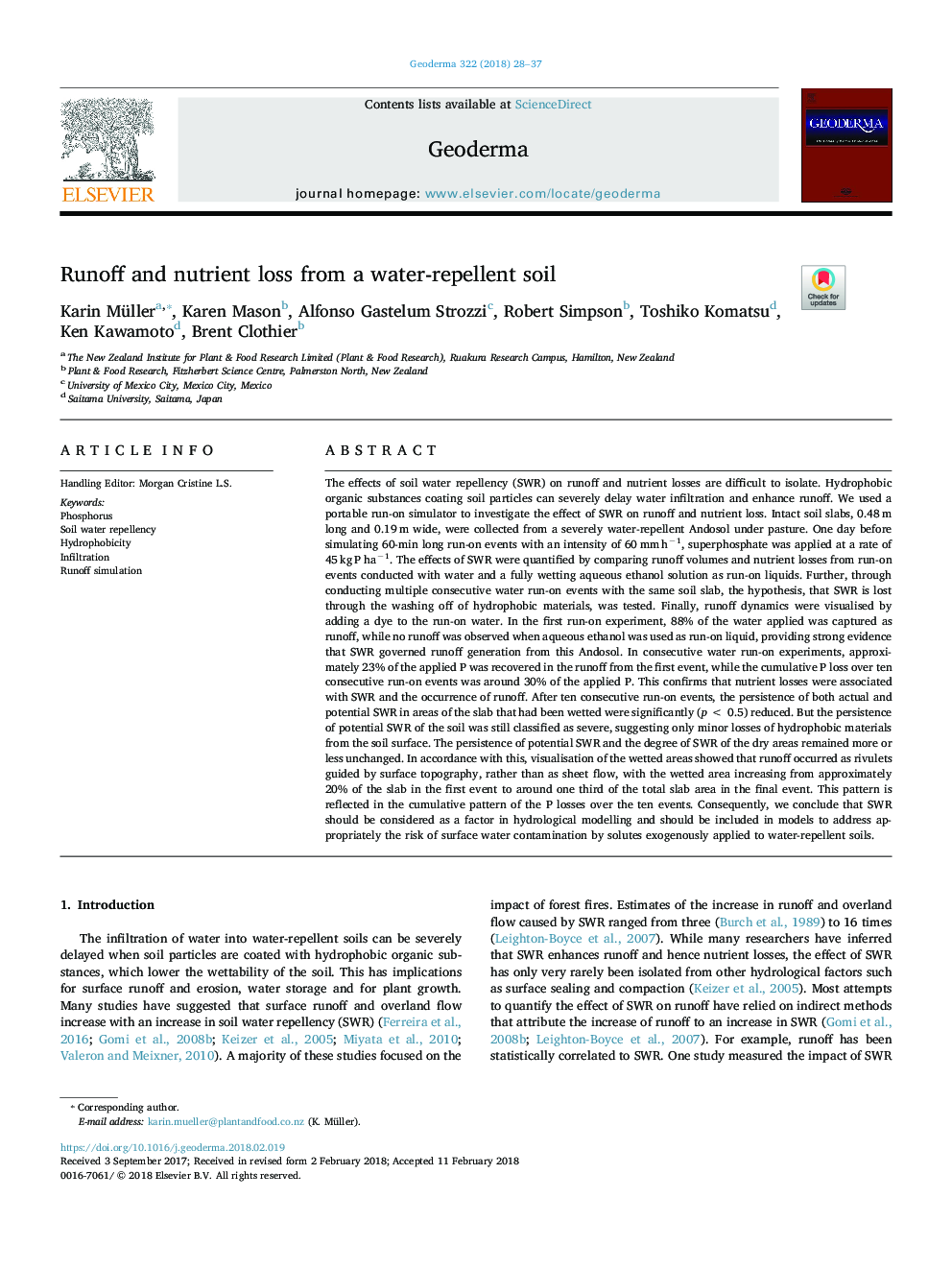| کد مقاله | کد نشریه | سال انتشار | مقاله انگلیسی | نسخه تمام متن |
|---|---|---|---|---|
| 8894063 | 1629395 | 2018 | 10 صفحه PDF | دانلود رایگان |
عنوان انگلیسی مقاله ISI
Runoff and nutrient loss from a water-repellent soil
ترجمه فارسی عنوان
فاضلاب و از دست دادن مواد مغذی از یک ماده ضد
دانلود مقاله + سفارش ترجمه
دانلود مقاله ISI انگلیسی
رایگان برای ایرانیان
کلمات کلیدی
فسفر، ضد خش آب هیدروفلوئید نفوذ، شبیه سازی رواناب،
موضوعات مرتبط
مهندسی و علوم پایه
علوم زمین و سیارات
فرآیندهای سطح زمین
چکیده انگلیسی
The effects of soil water repellency (SWR) on runoff and nutrient losses are difficult to isolate. Hydrophobic organic substances coating soil particles can severely delay water infiltration and enhance runoff. We used a portable run-on simulator to investigate the effect of SWR on runoff and nutrient loss. Intact soil slabs, 0.48â¯m long and 0.19â¯m wide, were collected from a severely water-repellent Andosol under pasture. One day before simulating 60-min long run-on events with an intensity of 60â¯mmâ¯hâ1, superphosphate was applied at a rate of 45â¯kgâ¯Pâ¯haâ1. The effects of SWR were quantified by comparing runoff volumes and nutrient losses from run-on events conducted with water and a fully wetting aqueous ethanol solution as run-on liquids. Further, through conducting multiple consecutive water run-on events with the same soil slab, the hypothesis, that SWR is lost through the washing off of hydrophobic materials, was tested. Finally, runoff dynamics were visualised by adding a dye to the run-on water. In the first run-on experiment, 88% of the water applied was captured as runoff, while no runoff was observed when aqueous ethanol was used as run-on liquid, providing strong evidence that SWR governed runoff generation from this Andosol. In consecutive water run-on experiments, approximately 23% of the applied P was recovered in the runoff from the first event, while the cumulative P loss over ten consecutive run-on events was around 30% of the applied P. This confirms that nutrient losses were associated with SWR and the occurrence of runoff. After ten consecutive run-on events, the persistence of both actual and potential SWR in areas of the slab that had been wetted were significantly (pâ¯<â¯0.5) reduced. But the persistence of potential SWR of the soil was still classified as severe, suggesting only minor losses of hydrophobic materials from the soil surface. The persistence of potential SWR and the degree of SWR of the dry areas remained more or less unchanged. In accordance with this, visualisation of the wetted areas showed that runoff occurred as rivulets guided by surface topography, rather than as sheet flow, with the wetted area increasing from approximately 20% of the slab in the first event to around one third of the total slab area in the final event. This pattern is reflected in the cumulative pattern of the P losses over the ten events. Consequently, we conclude that SWR should be considered as a factor in hydrological modelling and should be included in models to address appropriately the risk of surface water contamination by solutes exogenously applied to water-repellent soils.
ناشر
Database: Elsevier - ScienceDirect (ساینس دایرکت)
Journal: Geoderma - Volume 322, 15 July 2018, Pages 28-37
Journal: Geoderma - Volume 322, 15 July 2018, Pages 28-37
نویسندگان
Karin Müller, Karen Mason, Alfonso Gastelum Strozzi, Robert Simpson, Toshiko Komatsu, Ken Kawamoto, Brent Clothier,
